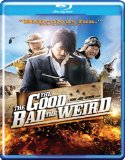Manchuria, the 1930s. The Japanese army has just acquired a treasure map, and are transporting it across the desert wastes by train. But the man who sold the map wants it back, and engages a snappily dressed killer (Byung-hun Lee) to steal it back. He is, of course, the Bad. He stages a spectacular (and spectacularly violent) train robbery. As fate would have it, at precisely the same moment, the Weird (Kang-ho Song) is also robbing the train, and the Good, in the form of a bounty hunter (Woo-sung Jung) is on board, too. The Weird makes off with the map, and what follows is a series of chases as the various factions scramble to get that map.
Director Ji-woon Kim’s tribute to Serio Leone’s The Good, the Bad and the Ugly follows its model’s characterization, with the leads’ cold-eyed killer, wacky scoundrel and cold-eyed hero clearly standing in for Lee Van Cleef, Eli Wallach and Clint Eastwood, only much prettier. The financial motivation and the setting of a country in chaos is similar, too. But while the film was a huge hit in Korea (outgrossing, it seems, the likes of The Dark Knight), it lacks the heart and brilliance of Leone’s film. There are some wonderful moments during the train robbery and other set pieces, but the film gets draggy in between. The tone is a little uneven, too – the intent seems to be entertaining, cartoonish violence, but the dismissive ways in which women are killed smacks rather uncomfortably of genuine misogyny. There’s a lot of visual pleasure to had here, but to ultimately mixed effect.
Video
Did I mention visual pleasure? The transfer is certainly up to conveying the movie’s eye candy. The image is crystalline, and the colours almost literally sing. Contrasts are terrific, and blacks, reds and blues are especially gorgeous. The desert landscapes are blindingly white yet gloriously detailed. Grain is non-existent, though there is a little bit of edge enhancement visible in a few shots. The aspect ratio is the original 2.351 anamorphic widescreen.
Audio
The sound is as much a pleasure as the picture. The score is sumptuous, surround the listener in truly thrilling fashion. The sound effects are spectacular – their placement beyond reproach, and even at lower volumes the sense of bullets striking various corners of the room is quite striking. Dialogue is undistorted. A thoroughgoing pleasure.
Special Features
Behind the Scenes: (15:02) Interesting footage showing how some of the more remarkable camera movements were pulled off, among other tidbits, but there is no explanation or narration – just footage.
Cannes Highlight Reel: (3:02) Again, no explanatory commentary is provided, though none is really needed of these scenes of the film’s reception at Cannes..
Making of #1: (3:22) A very short promo piece.
Making of #2: (1:02) And here’s one that’s even shorter. Why bother?
Interviews: With cast members Song (2:41), Lee (2:57), Jung (2:45) and director Lee (3:14). The subjects are all very soft-spoken, and there’s a fair bit of the obvious being pointed out about the characters. Nothing very in-depth, then.
Theatrical Trailer.
Final Thoughts
This isn’t an action film that’s going to remind you of the revelation that John Woo was back in the early 90s, and the film is finally too familiar. Still, some pleasures are to be had, that’s for sure.






